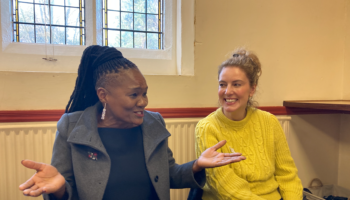Today’s post is on the long-awaited repeal of the amendment of Article 40.3.3 of the Irish Constitution, which was achieved in the referendum vote this past May.
The author is Clíona Ó Gallchoir, an academic in the School of English of University College Cork, Republic of Ireland. Clíona has expertise in Irish and British 18th and 19th century writing, Irish women’s writing, the writing of Maria Edgeworth, and the figure of the child in 18th century Ireland.
Clíona is also a former volunteer with VSO and has spent two years as a teacher trainer in Eritrea.
Ní Saoirse go Saoirse na mBan: There is no Freedom until Women are Free
On 25 May 2018, Irish people voted by a significant majority (over 66%) to repeal Article 40.3.3 of the Irish Constitution, otherwise known as the ‘Eighth Amendment’. This notorious amendment had been inserted in the Constitution in 1983 in order to guarantee the right to life of ‘the unborn’: foetal life at all stages from the moment of conception was described as having equal status with the life of ‘the mother’.
When it became clear that the proposal to repeal the Eighth Amendment had been overwhelmingly endorsed, the reaction among the majority of Irish women was not just one of profound relief, but also of joy and celebration. Although some had counselled that the response to a Yes vote should not be celebratory, in the end the joy of women, many of whom had campaigned on this issue for decades, could not be contained. The decision of the electorate, including 65% of the men who voted, was seen as the final, decisive rejection of a regime in which the control of women had been at the centre of how the Irish state defined itself.
The repeal of the Eighth Amendment was about much more than the decision, finally, to legislate for abortion in Ireland. It was also about an end to a shameful history in which unmarried mothers and children were institutionalized and abused so that a mythical image of Ireland as a country composed of perfect, patriarchal family units could be maintained. The facts of sex and pregnancy outside of marriage were not – in fact, could not be – acknowledged in a state in which adherence to a rigid version of Catholicism was upheld as a key marker of national identity. The inconvenient evidence that life in Ireland did not correspond to this strict ideological pattern therefore had to be hidden, and the Church and State operated in tandem to ensure that this was the case.
Pregnant girls and women were sent either to Mother and Baby Homes or to Magdalene Laundries. Women were often forcibly separated from their children, who were in some cases illegally adopted, either in Ireland or overseas, in transactions that benefitted the religious orders concerned. In other cases, children were, in their turn, institutionalized in orphanages, industrial schools, and sometimes, in a disturbing cycle, subsequently in Magdalene Laundries.
The fate of some of these children was uncovered in 2014 by Catherine Corless, a local historian living in Tuam, County Galway. Her research, originally disputed and ridiculed, found not only a shockingly high mortality rate among the babies and young children in the Tuam Mother and Baby Home, but also that the remains of potentially hundreds of children had been discarded in an unmarked mass grave, on a site on which a septic tank was later located. The total figure of bodies in this mass grave is as yet unknown, but a total of 794 children died at the Home and have no recorded place of burial.
This regime of institutionalization and incarceration gradually waned as the century progressed, but the last Magdalene Laundry did not actually shut until 1996. It is not hyperbolic to say that in the twentieth century women and children in Ireland who fell outside of the narrowly defined parameters of social acceptability were subjected to a form of state violence in the service of an ethno-religious identity.
In the most private and intimate ways, women’s bodies were controlled by a medical establishment that was dominated by Catholic teaching. Contraception was banned until 1980 (after which point it continued to be relatively inaccessible). The idea of women limiting their pregnancies or planning their families was so antithetical to the establishment that for decades, women in labour in some hospitals were subjected to the practice of symphysiotomy. This discredited procedure involves the breaking of the pelvic bones in order to facilitate childbirth, because caesarean sections were seen to present too high a risk for subsequent pregnancies, and might therefore be seen as a justification for birth control. There was no concern for the fact that the procedure left many women with lifelong chronic pain. The inclusion of the Eighth Amendment to the constitution in 1983 was therefore not an isolated occurrence, but part of a long history in which Irish women were treated as disposable, as acceptable collateral damage in an atmosphere in which ideology trumped reality.
The constitutional ban on abortion was however in some ways the most extreme form of ideological falsehood, and as the years passed, the gap between reality and ‘pro-life’ rhetoric became more and more difficult to sustain. In 1992, the case of a 14-year-old rape victim, who became the subject of an injunction preventing her from travelling to the UK for an abortion, exposed the full extent of the barbarism inherent in the constitutional ban.
The response of the government at the time was to amend the amendment, giving women a constitutionally-guaranteed right to travel for abortion services, thus formalizing an extraordinary hypocrisy. It is estimated that 3,000-4,000 Irish women access abortion in the UK annually; meanwhile, however, importing and taking an abortion pill in Ireland is currently punishable by a sentence of 14 years imprisonment. The Ryanair flight to London, Liverpool or Manchester, and the illegally-imported packets of pills, taken alone at home in fear of the consequences, are the twenty-first century equivalent of the hiding of ‘fallen women’ inside the high grey walls of institutions.
Is it any wonder that Irish women wept, then sang and cheered when they realized that they no longer had to be the secret that Ireland kept about itself? They also wept for the memory of Savita Halappanavar, whose tragic death in 2012 was caused by the fact that doctors could not terminate her unviable pregnancy for as long as any foetal heartbeat was detected. By the time they realized she had developed sepsis, it was too late to save her. The Yes vote was a belated but necessary atonement for the fact that a woman who had come to Ireland to make her home and start a family had died, cruelly and unnecessarily.
This historically significant result comes at a time in which Ireland is developing a new relationship to its history, and in which some of the buried potential of Irish radicalism is being reclaimed. In contrast to the highly-conservative nature of the Irish state after independence, those involved in the campaign for Irish independence in the early twentieth century were also involved in trade unionism, in educational reform, in campaigns for women’s suffrage, in anti-imperialism more generally, and in campaigns for housing and health. Following independence, the aspirations for a nation and a state that gave a better life to all its citizens dwindled in the face of economic stagnation and political instability. The meaning of Irish independence shrank to a sterile assertion of national distinctiveness understood largely in terms of the identification of Irishness with Catholicism. As we have seen, in order to preserve the image of ‘Catholic Ireland’, women and children who did not fit its image were hidden, silenced and often brutally excluded from society.
But things are changing. In 2016, one of my neighbours in Cork city hoisted a green flag emblazoned with the words ‘The Irish Republic’: this, not the Irish tricolour, was the flag that was flown by the rebels during the Easter Rising of 1916. Around the corner, in another front garden, the ‘starry plough’ could be seen: this was the flag of the Irish Citizen Army, a republican socialist organization led by James Connolly, who was later executed for his part in the Rising. These flags represented a slightly subversive response to the the fact that the Irish political establishment had decided, initially tentatively, to celebrate the centenary of the Rising, which is traditionally seen as the foundational moment of the independent Irish state.
Since the outbreak of the Northern Ireland conflict (‘The Troubles’) in the late 1960s, celebrations of ‘physical force’ nationalism had become politically toxic, and official commemoration of 1916 was for decades extremely muted. In 2016, however, with the Northern conflict consigned to history, the government decided that it could safely lay claim to the historical tradition of Irish nationalism.
Something happened in 2016, however, that was entirely unexpected. Ordinary people and communities displayed enormous curiosity and enthusiasm for the history of the revolutionary period. Local groups organized lectures, memorial events, plays, parades and celebrations. But following nearly a decade of economic austerity and in the wake of an endless cycle of scandals about abuse and neglect of the vulnerable in church institutions, facilitated by the state, the enthusiasm of Irish citizens was not for the official version of history. The flags that were flown by my neighbours were a reminder that the Ireland that was created after independence was not the only Ireland possible – there were and there are other possible futures.
The sense of an aspiration for these new futures was already evident a year prior to the centenary celebrations, when the Constitution was amended by popular vote to guarantee marriage equality to same-sex couples. A document largely authored by the arch-conservative Eamon De Valera had been rewritten to reflect values of tolerance, equality and respect for diversity. The referendum result in 2015 was undoubtedly indicative of progress in terms of attitudes in Ireland, but it was also part of the movement to reverse the clerical control that had been imposed on Irish society since independence.
The 1937 Constitution was in many ways a concerted move to erase those elements of political thought that did not fit with De Valera’s conservative worldview: this was recognized and resisted by women such as Kathleen Lynn who had been active in the revolutionary period and who campaigned against the adoption of the new constitution. The campaign to repeal the Eighth Amendment was thus not just a moving forward, but also a movement back, to reclaim the history of women who had imagined and worked for an Ireland that they hoped would bring equality for all.
For nearly 100 years, the idea of women’s equality in Ireland was abandoned in the interests of a particular version of Irish nationalism. The fact that there were advanced feminist movements in Ireland in the early twentieth century was either forgotten, or dismissed as trivial. The recovery of that history was however evident in the popular campaigns with slogans in the Irish language: #TáForMná (‘Yes for Women’) trended on Twitter; people wore sweatshirts that proclaimed ‘Stand in Awe of All Mná’ (from Emmet Kirwan’s powerful poem ‘Heartbreak’); and an old slogan resurfaced: ‘Ní Saoirse go Saoirse na mBan’ (‘No Freedom Until Women Are Free’).
The Repeal Campaign can be seen as a social movement that recalls some of the radical feminist and progressive ideas of the past, and that creates a new cohort of women engaging in activism and political campaigning, many of them for the first time. Because of this, although the euphoria of the result will fade, the campaign will resonate into the future.








